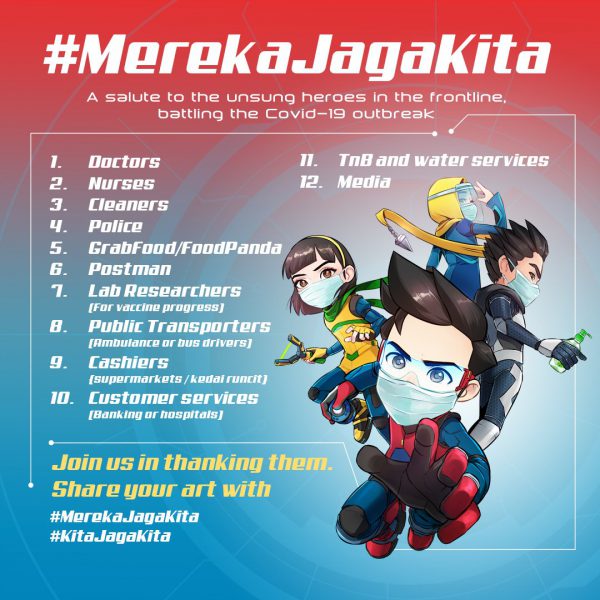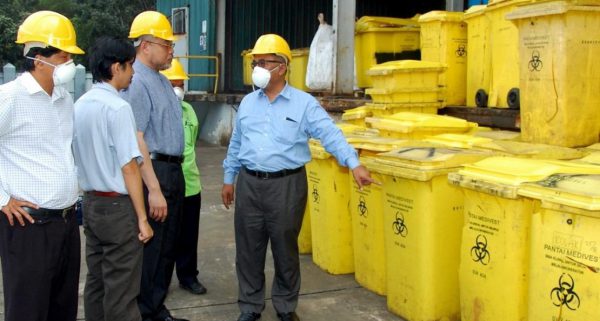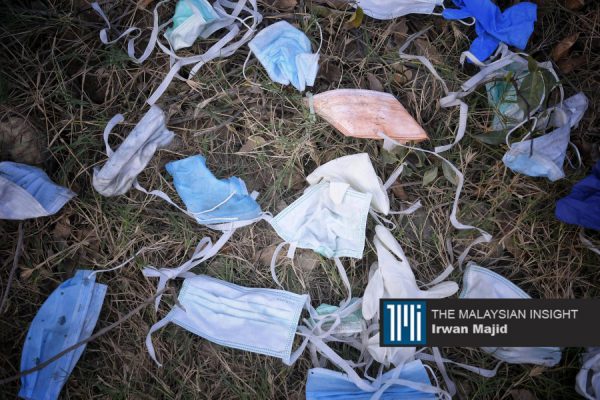Clinical waste in Malaysia has risen 27% since MCO. How are we getting rid of it?

- 379Shares
- Facebook326
- Twitter7
- LinkedIn6
- Email12
- WhatsApp20
Given that we’re more or less six weeks into the Movement Control Order (MCO), we suppose you’ve had quite a lot of time to read up on a lot of stuff about the Covid-19 virus, swiping your phone every now and then to find out the latest updates about the status in Malaysia, regardless of whether real or fake.
You’ve probably also seen a lot of photos or posts like this…

Our frontline workers, especially healthcare staff, have undoubtedly contributed a lot to curb the pandemic, working around the clock to look after Covid-19 patients. We suppose it’s safe to say that they’re rightfully the true heroes in these trying times.
However, while the healthcare workers have been doing their best to look after Covid-19 patients and ensure that as many people as possible are discharged from the hospitals with clean bills of health, there’s also something else that the hospitals have been discharging: clinical waste. It’s kinda inevitable for healthcare facilities to produce clinical waste. In fact, there’s clinical waste everyday.
But the thing is…
Clinical waste has reportedly increased by 27% since Covid-19

Before we get into the other stuff, let’s start with: what’s clinical waste?
Clinical waste is ultimately scraps that come from healthcare activities or within a laboratory, and can potentially threaten human health or even the environment if exposed. The waste can include things like syringes, bandages, gloves, blood bags, organs, and personal protective equipment (PPE), as long as they:
- Contain materials that can cause diseases
- Have been contaminated by any type of medicine that contains biologically active pharmaceutical agent
- Are sharp and contain body fluids, like needles
Different countries have different regulations and methods to manage clinical waste, and that includes Malaysia. So here, clinical waste is classified as scheduled waste under the Environmental Quality Act 1974. In addition, the Health Ministry has included its own guidelines that are more specific on what should be considered clinical waste, which you can find here.

Apparently, the total clinical waste that’s generated in the country can total up to around 40,000 metric tonnes per year, with each bed producing around 0.3 to 0.8kg of clinical waste per day and healthcare workers contributing to the number as well. However, when the Covid-19 cases spiked in Malaysia, the same is happening with our clinical waste. It was reported that clinical waste increased by 27% in March itself.
According to Environment and Water Minister Tuan Ibrahim Tuan Man, it’s a much higher percentage compared to earlier annual average, due to a higher quantity of disposed gloves, face masks, and clinical attires.
“The higher content is still within the permissible limit and the public need not worry about using water.” – Tuan Ibrahim, as quoted from Malaymail
But essentially, according to the Department of Environment, an excessive amount of clinical waste can create a lot of problems, like threats to health, safety, and environment. That’s why it’s important for such waste to be disposed of responsibly and completely, so it got us thinking…
What’s the procedure of disposing clinical waste in Malaysia?

As we’ve mentioned above, clinical waste management is regulated under the Environmental Quality Act 1974, or more specifically the Environmental Quality (Scheduled Wastes) Regulations part of the act. This is to rationalize and recommend consistent methods for the management of clinical waste within the country and make sure there’s no spillover.
There are several stages that are employed to deal with clinical waste, which are:
- Segregation
- Collection
- Transportation
- Disposal
The first stage of clinical waste disposal is called the segregation stage. Segregation means separating and color coding the wastes that have been discharged in daily healthcare activities. For example, infectious wastes that should be autoclaved – or steam sterilized – will be put in blue plastic bags or containers, wastes that are to be incinerated directly in yellow, and general wastes in black. For wastes that have been coded blue, they’ll be placed into yellow containers after sterilization for ultimate disposal. Meanwhile, sharp objects have to be deposited in a special bin.
If it’s a hospital, the staff are directly involved in the process of segregating the wastes, where they have to ensure that all clinical wastes are discarded almost immediately after use. In addition, they have to make sure that they don’t mess up the color coding system.

After the stage of segregation, comes the collection stage, which is basically when these waste bags, containers, and bins are collected to be transferred to a temporary storage location. It happens on a daily basis, and for a majority of hospitals, collection usually goes from 8.30 to 11.30 in the morning, but not everyone can just go around collecting.
Apparently, hospitals have designated porters to go around the hospital and collect the clinical waste with 660-liter wheeled bins, and then the wastes will be transferred to a temporary cold storage location and restored in 15kg wheeled bins.
“The porters should be properly trained in handling medical waste and should wear suitable personal protective equipment, including a face mask, an apron, gloves, and shoes.” – Facility management senior adviser Hong Poh Fan, as quoted from Privatization of Facility Management in Public Hospitals
Temporary cold storage locations can usually be found in the hospitals from where the wastes are collected from, but are required to be separated from general wastes to avoid contamination and infection. It’s stipulated that the wastes should only stay in temporary storage for no longer than 48 hours before transportation. In the meantime, the wastes in blue containers will be sterilized and replaced into yellow containers.

After that, the clinical waste will be transported to disposal sites in special vehicles licensed by the DOE. The Health Ministry’s also made it compulsory that a hospital personnel is present to verify and provide full documentation of the wastes that are to be disposed of. And while these vehicles are transporting the wastes to disposal sites, they must avoid heavily populated areas and water bodies.
When it comes to actual disposal, Malaysia apparently has several methods to do so:
- Incineration: Using a comprehensive waste treatment facility to simply burn the clinical waste into ash
- Material recovery and recycling: Before collection, experts will try to look for materials that can be recovered and recycled after sterilization, which can be helpful to the environment and reduce the amount of wastes requiring incineration
- Landfilling facilities: Employing unused tin mines as landfills to dispose clinical waste without the need for incineration
And et voila, no more clinical waste. With regulations and guidelines from both the Health and Environment Ministries, Malaysia seems to have a rather comprehensive system in place to deal with clinical waste. And if a party doesn’t comply with the guidelines provided, they can be heavily penalized, which can include revoking operating permits, fines, and imprisonment.
But still, even with the seemingly comprehensive system in place…
There’s been a lack of training on how hazardous clinical waste can be

A study in 2014 found that there’s a lack of awareness and training for proper clinical waste management among those who are involved in the segregation stage, such as hospital staff like doctors and nurses. Apparently, there’s quite a number of hospital personnel who don’t really know how to categorize and color code clinical waste or even how long clinical waste should be kept in cold storage before disposal. And this can easily lead to clinical waste and general waste getting mixed up in the end.
“Lack of proper training in the hospitals poses serious risks to personnel as far as the hazards of hospital waste is concerned.” – Dr. Dasimah Omar, Dr. Subramaniam Karuppanan, and Siti Nurshahida Nazli, as quoted from International Journal of Innovation, Management and Technology
It’s not just the lack of training that poses a challenge. Storage locations in hospitals themselves are also kinda problematic, because hospitals apparently are unable to provide a large enough space to store the bins that the porters use. As such, there’s not enough space to properly clean the bins or, sometimes, even at all. There are even cases of clinical waste bins being stored together with general waste due to the lack of space.
It also doesn’t really help when general users like us are prone to littering like discarding face masks on the streets – yes, face masks are somewhat considered clinical waste as well.

The current amount of clinical waste is still manageable though
Despite some of the obstacles surrounding clinical waste management, no problems have surfaced in consequence as far as we can tell, where clinical waste’s still dealt with using the usual procedure, so we suppose that’s a good thing. But still, it’s probably wiser for clinical waste producing facilities to start providing training so as to avoid future complications.
As for the current situation, while it’s true that the number’s risen quite significantly, Tuan Ibrahim’s reassured the public that it’s still manageable and there’s no need to worry about possible impacts on the environment just yet.
“The ministry through the Department of Environment (DOE) will ensure such waste disposal is managed properly with regular collection and we are monitoring the concession companies appointed by the government to ensure the waste is properly disposed of to prevent pollution to the environment.” – Tuan Ibrahim, as quoted from Malaymail
And perhaps we should also do something to prevent unnecessary increase in the amount of clinical waste, such as, you know, not throwing gloves or face masks everywhere, because #kitajagakita.
- 379Shares
- Facebook326
- Twitter7
- LinkedIn6
- Email12
- WhatsApp20



